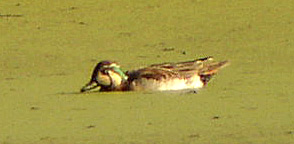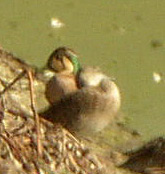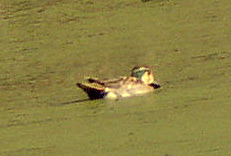Baikal Teal (Anas
formosa)
Mission Hills Sewage Treatment Plant, Lompoc, Santa Barbara County, California
12 December 2005
Joseph Morlan
Photos © 12 December 2005 by
Joseph Morlan. All rights reserved.
© 12 December 2005 by
Joseph Morlan. All rights reserved. 
Today, I decided to drive down to Lompoc hoping to see the Baikal Teal found 10 December by Wes Fritz. I arrived
at the dirt road that runs along the outside of the Mission
Hills Sewer Plant about 10:30am. There I recognized Kaaren Perry who advised me that I could see the teal by
standing on the hillside with the other people who had scopes trained on the bird. The Baikal Teal was swimming
out in the open at the far end of the third pond when I got to the viewing area. The light was good and I was able
to watch the bird for about a half hour before it hauled out on the far shore. At first it stood on the shore feeding
on the floating green algae. After disappearing for a while behind a female Blue-winged Teal, it eventually reappeared
and worked its way up the embankment away from the other ducks. Most of the original observers left while I was
there, but they were replaced by additional observers and I was able to show them the bird. I spent about 45 minutes
with the bird, but much of the time was spent attempting photographs.
Description
I did not take notes at the time, but concentrated on photography instead. Photos were digiscoped from a considerable
distance (approximately 1,000 feet), hand-held, with an Olympus D-550z / Nikon FieldScope 3 / 30XWA. I probably
could have obtained better images by getting permission to enter the ponds, but I opted to stay outside the fence
to avoid flushing the bird and disappointing arriving birders.
From memory and reference to photos I can say, that it was a small duck, about the size of Blue-winged/Cinnamon
teal, but clearly smaller than adjacent Northern Shovelers. The head was boldly patterned. Its face was pale yellowish
buff with a contrasting large dark eye with an irregular blackish eyering. A black line extended from the rear
of the eye down the side of the face and looped under the head, connecting to the black chin and throat. A broad
wedge-shaped iridescent green stripe began at the top of the eye and curved back, broadening at the nape and connecting
across it. This green patch was bordered above by a crisp pale yellowish buff stripe, separating the green from
the contrasting dark crown and forehead. The body was grayish with fine gray vermiculations on the sides. The long
scapulars were rusty brown and curved down over the wing coverts. The tertials were mostly gray with black edges.
The tail seemed rather long, grayish centrally, but with rusty edging to the bases of the outer rectrices. The
undertail coverts were black contrasting with a white flank patch. A small white stripe was visible extending down
the side of the breast from the shoulder, similar to the more extensive white shoulder stripe found on male Green-winged
Teal. The breast was brownish with a purple cast, recalling the coloration of American Wigeon. The bill was dark,
outlined with black at the base and with a fairly broad black tip.
Photos taken by Jim Greaves on 10 December have been posted here.
Additional photos taken by Andrew Birch on 11 December are here
and here.
Discussion
 Identification is relatively
straightforward, although some hybrid duck combinations are known to produce birds with a superficial resemblance
to Baikal Teal. Sibley (June 1994, Birding) discussed hybrid ducks (neither parent being a Baikal Teal)
that can look like Baikal Teal. Click here
for discussion on the ID Frontiers mailing list regarding such hybrids. An example of such a misidentified hybrid,
is a claimed Baikal Teal from the Cayman Islands photographed here.
This bird is clearly a hybrid involving Northern Pintail and some other species. 'Hybrid Ducks' by Eric
& Barry Gillham has several photographs of drake hybrids, involving Green-winged Teal, Northern Shoveler, both
wigeons, Falcated Duck, Northern Pintail and Gadwall in various combinations, showing this 'bimaculated' pattern,
which may be an ancestral trait. Similar birds have also been seen in the field in Europe and in California. Nevertheless,
the combination of head pattern on this bird, combined with the long scapulars and body plumage is typical of true
Baikal Teal. I see no evidence of hybrid origin for this individual.
Identification is relatively
straightforward, although some hybrid duck combinations are known to produce birds with a superficial resemblance
to Baikal Teal. Sibley (June 1994, Birding) discussed hybrid ducks (neither parent being a Baikal Teal)
that can look like Baikal Teal. Click here
for discussion on the ID Frontiers mailing list regarding such hybrids. An example of such a misidentified hybrid,
is a claimed Baikal Teal from the Cayman Islands photographed here.
This bird is clearly a hybrid involving Northern Pintail and some other species. 'Hybrid Ducks' by Eric
& Barry Gillham has several photographs of drake hybrids, involving Green-winged Teal, Northern Shoveler, both
wigeons, Falcated Duck, Northern Pintail and Gadwall in various combinations, showing this 'bimaculated' pattern,
which may be an ancestral trait. Similar birds have also been seen in the field in Europe and in California. Nevertheless,
the combination of head pattern on this bird, combined with the long scapulars and body plumage is typical of true
Baikal Teal. I see no evidence of hybrid origin for this individual.
Recent genetic studies by Johnson and Sorenson indicate that Baikal Teal is not closely related to any other
Anas species (The Auk 116:792-805, 1999).
King (Birding World 12:344, 1999) noted that Anas hybrids often show Baikal-like facial patterns, and speculated
that this may be a reappearance of characters that are ancestral to the whole dabbling duck tribe.
The bird's plumage has been a matter of discussion. The bird is clearly a male, but it has more brown on the
scapulars than would be expected of a full adult. Also the white shoulder stripe is incomplete, the supercilium
is buffy instead of white, and the white trim along the lower border of the green face patch found in fully adult
males is not evident. These features may be due to retained juvenal plumage or retained "eclipse" plumage.
In this species, some juvenal plumage feathers are known to persist until the following summer (Madge & Burn
1988), while adults usually attain full plumage by late fall (Palmer 1976). Thus I think it is likely that this
is a hatching year bird.
There are five previously accepted records of Baikal Teal in California, all specimens:
BAIKAL TEAL Anas formosa (6,5,1,0)
Accepted
1. 29 Dec 46 Niland IMP 107-1983-8 (#MVZ)
2. 12 Jan 74 Riverside RIV 108-1983-8 (#SBCM)
3. 27 Nov 74 Honey L. LAS 109-1983-8 (#HSU)
4. 4 Jan 75 Gray Lodge BUT 110-1983-8 (#HSU)
5. 14 Oct 87 Tule L. NWR SIS/MOD 175-1988-13 (#private)
Not Accepted, natural occurrence questionable
13 Dec 31 Brentwood CC 106-1983-10,14 (#MVZ)
Records from Colorado, Oklahoma, Louisiana, Ohio, Pennsylvania, New Jersey, North Carolina, and Ontario are
usually regarded as escaped captives (AOU 1998, ABA 2002), although the natural provinence of some of these records
has been argued. Records from Alaska, British Columbia, Washington and Oregon are usually considered natural. The
natural occurrence of records from Europe is difficult to assess.
Because of over-hunting and pesticides, the Baikal Teal underwent a serious population decline in past decades.
By the 1980's Baikal Teal populations had plummeted to a total world world population estimated to be only 20,000
birds. However, recent conservation efforts have been extremely successful and upwards of 400,000 Baikal Teal now
winter in Korea alone. More details of this comeback can be found at the BirdsKorea
web site. The Baikal Teal is now Korea's most common duck and I think its recent recovery greatly increases
the odds of finding stray wild birds in North America or Europe.
Updates, additions and corrections
13 December
- More information on the discovery and additional photos by Dawn King taken 10 December have been posted on
the La Purisima Audubon Society web site.
- Another 10 December photo by Brad Schram has been posted here.
- A sight record of this species by Jim Livaudias 20 March 2004 from Lower Klamath NWR was mentioned in NAB
(Spring 2004). Additional information was posted on Calbirds here.
As far as I know, no other details are available and this record has not been submitted.
- Full details with photos of an immature male Baikal Teal at Kauai, Hawaii Dec-Jan 2003 has been posted here.
This site includes much research on status in captivity as well as molt and aging.
- Detailed discussion and photos of a similar looking Baikal Teal at Minsmere are here.
This article includes a detailed critique of aging criteria and molt.
- The bird was still present this morning, but had apparently moved to the fourth pond.
- The bird was still present this afternoon on the 3rd and 7th ponds. A white collar below the green face patch
was noted by Mike Rogers.
14 December
- Bird seen today and well photographed from inside the fence by Roger Millikan. Photo here.
15 December
- Bird seen today. A flight photo by Brad Schram taken 10 December reveals the right rear toe is intact and not
clipped. Right rear toe clipping before the age of six weeks is an approved methods of marking captive bred waterfowl
intended for release or sale. Cf. here. Bird is unbanded
and wary.
16 December
- Baikal Teal still present.
17 December
- Baikal Teal not seen all day.
18-23 December
- Baikal Teal still present.
21 December
- Article published in the Santa Maria Times newspaper here.
24 December 2005 - 8 January 2006
9 January 2006
- Baikal Teal refound at the same place and photographed by Mary Beth Stowe. Full account with photos here.
10 January 2006 - present
 © 12 December 2005 by
Joseph Morlan. All rights reserved.
© 12 December 2005 by
Joseph Morlan. All rights reserved. 

 Identification is relatively
straightforward, although some hybrid duck combinations are known to produce birds with a superficial resemblance
to Baikal Teal. Sibley (June 1994, Birding) discussed hybrid ducks (neither parent being a Baikal Teal)
that can look like Baikal Teal. Click
Identification is relatively
straightforward, although some hybrid duck combinations are known to produce birds with a superficial resemblance
to Baikal Teal. Sibley (June 1994, Birding) discussed hybrid ducks (neither parent being a Baikal Teal)
that can look like Baikal Teal. Click